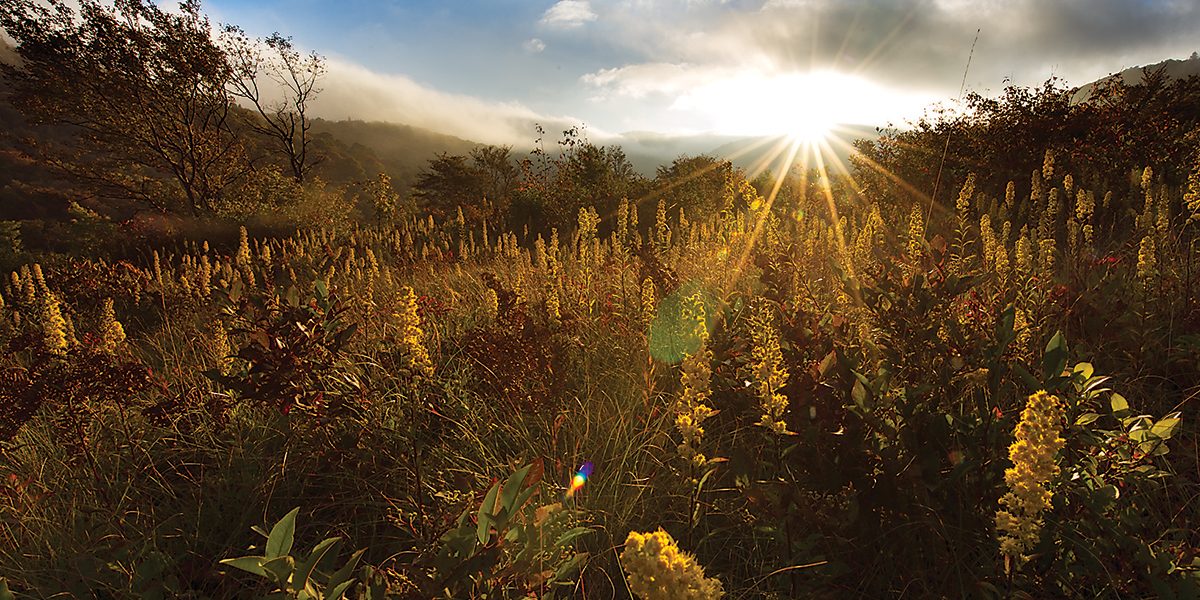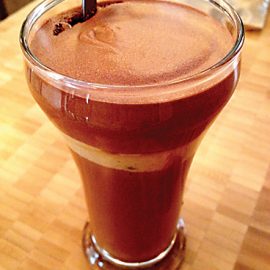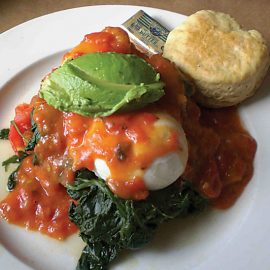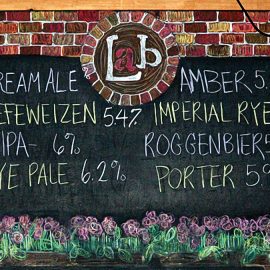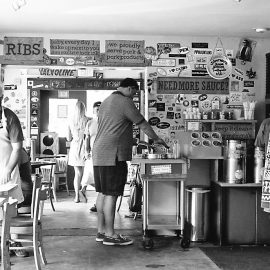Travel & Outdoors
Dreaming of Asheville
With its quaint downtown and picturesque setting, the North Carolina city appeals to hipsters, foodies, music lovers, and, well, everyone else.
When you get to Asheville/ Send me an e-mail/ Tell me how you’re doing/ How it’s treating you/ Did you find a new job/ Did you find a new love/ Is it everything that/ You were dreaming of —“When You Get to Asheville” by Steve Martin, Edie Brickell, and the Steep Canyon Rangers.
When you get to Asheville, very likely you will not be in search of a new job or a new love, although you certainly might find that the western North Carolina city, framed by two mountain ranges and with a gorgeous river running through it, is not simply what you were dreaming of, but considerably more. That includes not only its bucolic setting, but also its vibrant arts and culture community, its ample supply of diverse dining choices, a plethora of imaginative vintage clothing boutiques, a mind-numbing (literally and figuratively) array of breweries/brewpubs, an astonishing number of indie bookshops, a vaunted music scene, and, perhaps most tellingly, a pervasive hip-without-trying vibe.
Often described as the “Paris of the South”—a stretch, frankly, that does a disservice to both cities—Asheville, with a manageable population of 86,000 and a distinctly unhurried sensibility, comes off more like a mini-Austin, reminiscent of the Texas capital before it mushroomed into an infrastructure inferno over the past 25 years.
About a seven-and-a-half-hour drive southwest from Baltimore, Asheville rests between the Great Smoky Mountains to the west and the Blue Ridge Mountains to the east and south, with the French Broad River winding obligingly through its midst. Given this veritable surround-sound of rusticity, outdoor opportunities—hiking, climbing, and rafting/canoeing—abound. Choose from among dozens of nearby trails, from the tractable Graveyard Fields (kids can easily handle the mostly flat terrain and ogle a pair of oooo-aahhhh waterfalls) to the challenging Grandfather Mountain. (Intrepid types will appreciate its backcountry trails that require ladders and cables to ascend sheer rock faces, although it also offers less arduous treks.)
Consistently cited as a top whitewater destination by outdoors publications and organizations, Asheville’s hometown river affords both leisurely canoeing/floating and eight miles of varying-sized rapids for kayakers as its waters wend through adjacent Pisgah National Forest.
Inveterate city dwellers no doubt will prefer the concrete-and-green-space walkability of the compact downtown’s Asheville Urban Trail, a 1.7-mile amble that combines history lessons, architectural highlights, and often whimsical public art. Composed of 30 separate stations and covering five discrete historical periods dating from western North Carolina’s frontier days, each stop is marked by a sculpture, plaque, or significant building that represents and illuminates an aspect of the city’s past, including the Paul Bunyan-esque Flat Iron, the refined Art Deco S&W Building, and the elegant iron bench memorializing Elizabeth Blackwell, who, in 1849, became the first woman to earn a medical degree in the U.S.
Also on the historical beat and unquestionably the city’s top attraction (Memo to cynical tourists: You will regret shrugging it off): Biltmore Estate, the 250-room, 8,000-acre Gilded Age manor built for American aristocrat George Vanderbilt (industrialist Cornelius Vanderbilt’s grandson). Completed in 1895 as Vanderbilt’s country home, Biltmore, located just outside downtown and designed in the mode of a French Renaissance chateau, exudes an outsized opulence seldom seen in the United States. (Think Downton Abbey.) Its four floors boasting 35 bedrooms, 43 bathrooms, and 65 fireplaces—not forgetting a gargantuan indoor swimming pool, period-equipped gymnasium, and two-lane bowling alley—are extravagances Downton’s Lord and Lady Grantham would envy.
A self-guided audio tour leads visitors through high-ceilinged, ornately decorated spaces, whose names often invoke the old Clue board game—billiards room, banquet hall, music room, library, breakfast room, smoking room, and sitting room, plus dozens of “branded” bedrooms, such as the Louis XV—all brimming with the furniture, tapestries, and art (portraits by John Singer Sargent, early works by Renoir) chosen or commissioned by George Vanderbilt. The tour concludes in the vast basement, site of the servants’ quarters and their working areas, notably state-of-the-art (for the early 20th century, anyway) kitchen, laundry, and refrigerated storage closets.
The sprawling grounds—designed by landscape architect Frederick Law Olmsted, also responsible for New York’s Central Park and Baltimore’s Mt. Vernon Place among other locations—feature 75 acres of formal gardens, plus informal gardens, ponds, a forest, former stables, and a spectacular greenhouse. Leisurely stroll the grounds or hike various trails, notably one that follows the French Broad River. Since 1971, the estate also has produced grapes on land formerly worked by Biltmore’s tenant farmers. A winery (tourable, like all else here), housed in the estate’s retrofitted dairy, processes those grapes into a shifting menu of Biltmore-label vintages, available for sampling in its tasting room, a recommended activity at the conclusion of a Biltmore-centric day.
Dramatically less dazzling but important for literary reasons, the Thomas Wolfe Memorial,
on the north side of downtown, permits devotees of the 20th-century
author to roam Wolfe’s childhood home, a boarding house run by his
mother. Wolfe used it as the basis for Dixieland, a rooming house in his
celebrated autobiographical novel Look Homeward, Angel; the
29-room Victorian, brimming with original furnishings, now functions as
the nation’s de facto Wolfe museum. The author rests in the city’s
Riverside Cemetery, as does 19th-century short-story king O. Henry.
Asheville’s literary bona fides extend to current author Sara Gruen (the best-selling Water for Elephants), who lives there. And the city must teem with readers judging by its numerous bookstores, from the specific—Spellbound Children’s Bookshop, Battery Park Book Exchange & Champagne Bar—to the general, Malaprop’s and Downtown Books & News, the latter two distinctive for yin-yang reasons.
Malaprop’s
stock, all new, ranges from bestsellers to histories to literary
fiction to graphic novels—Stephen King cheek-by-jowl with George
Saunders—many affixed with scribbled staff recommendations. You get the
unmistakable impression that the people who work here love to read.
Downtown Books & News, by contrast, groans with shelves of used
volumes (everything imaginable) and a remarkable selection of
thoughtful, often obscure magazines and journals, plus alternative
comics and a rack of local/regional magazines.
Downtown Books sits amid a bustling Lexington Avenue shopping district, chock-a-block with clothing boutiques, restaurants, bars, and coffee/tea shops. Tightly bunched, the trio of Honeypot, Hip Replacements, and Vintage Moon
artfully mixes smartly chosen retro and new women’s wear and
accessories. (Vintage Moon seems to have bought out Stevie Nicks’s old
stage outfits.) Pop into Dobrá Tea or adjacent Izzy’s Coffee Den to admire your purchases, check your e-mail, or simply catch your breath.
Even better, walk a few blocks south to French Broad Chocolate Lounge,
source of the “liquid truffle,” 4.5 ounces of thick, complexly flavored
chocolate bliss: pure dark, milk chocolate, lavender and honey, and
cayenne and cinnamon (among other choices), the latter combo producing a
satisfying scalp sweat like the one induced by Indian food, and all of
them requiring a tiny spoon for consumption. Also available, a dizzying
array of intensely chocolate options, both drinkable (hot and cold) and
edible (bars, cakes, cookies, tarts, brownies, mousses, and trifles).
They take chocolate to the level of nerdy connoisseurship here, buying
cocoa beans from farmers in Peru, Costa Rica, and Nicaragua; processing
them in small batches at the business’s own nearby “bean-to-bar”
factory; and listing the percentage of chocolate purity on its products
and menu.
What with the extreme coziness of the city, it seems
silly to stay anywhere but downtown, allowing you to stow the car except
for trips to Biltmore and outdoors activities. A mere stroll to the
city center, the Arts and Crafts-style Carolina Bed & Breakfast,
located in the Montford Historic District, offers six rooms and a
cottage, all with fireplaces and free Wi-Fi. The full breakfast includes
breads, cookies, and cakes, plus jams and jellies, made in the Carolina
kitchen, augmented by vegetables grown in its garden or sourced
locally.
Smack dab in the middle of the city, Aloft Hotel,
the boutique brand of the Starwood chain, evinces a palpable modernity
without tipping over into streamlined soullessness. Smoke-free,
pet-friendly, and blessed with a rooftop pool that affords an unimpeded
mountain vista, it opened in 2012 and still glistens with a shiny,
happy—if corporate—ambiance.
Topping Asheville’s wide range of
dining cuisines for visitors, not surprisingly: Southern. (Would you
order Italian food on vacation in Hong Kong?) In terms of price, you can
go high-end at The Blackbird (grilled pork chop with bourbon sweet potatoes and caramelized apples), medium at Tupelo Honey (Southern fried-chicken saltimbocca with country ham and mushroom Marsala), or down-home at the lunch-only 12 Bones Smokehouse, where President Obama has dropped in for ribs on three occasions.
Perhaps more intriguing, though, is the Tex-Mex-meets-Deep-South Local Taco,
which packs its tacos with pork-butt barbecue, buttermilk-fried
chicken, or smoked brisket, joined by de rigueur sides of collard greens
and Mexi tater tots.
Meanwhile, don’t even consider breakfast or lunch anywhere but the cheery Early Girl Eatery,
which infuses its Southern-ness with healthfulness (gluten-free
options!). A few hearty and occasionally heart-clogging examples: shrimp
with grits; vegan tofu scramble; fried pie filled with pork belly,
caramelized onions, and spinach-and-cheese curd; banana-walnut pancakes
accompanied by garlic potato cakes topped with tomato gravy; and
shiitake mushroom/green tomato/cheese-curd quiche. Biscuits are advised,
spread with real butter and raspberry jam from a squeeze container.
Asheville’s
groovier-than-thou attitude has resulted in a cornucopia of vegetarian
restaurants, all serviceable, with one standout: Rosetta’s Kitchen, whose staff brings a punk-y vitality to the food, customer service (direct but cordial), and raging in-house soundtrack.
Like
Baltimore, Asheville has become the beneficiary of—or fallen victim
to—the food-truck phenomenon, boasting a handful of roving restaurants.
When touring the urban trail, shopping, or browsing bookshops, keep an
eye peeled for El Kimchi (Korean-Mexican), Ceci’s Culinary Tour (Latin American), Gypsy Queen Cuisine (Lebanese), and Pho Ya Belly (Vietnamese).
Beer
culture thrives in Asheville, with, quite possibly, more regional
specialty breweries per square mile than anywhere in the known universe.
The Asheville Brews Cruise will ferry you to tour—and
sample the wares at—nine of them: Green Man, French Broad, Pisgah,
Oyster House, Highland, Altamont, Burial, Wicked Weed, and Hi-Wire. Many
local bars and restaurants also feature these companies’ products.
Alternatively, drink directly from the source at Lexington Avenue Brewery,
whose 15 floor-to-ceiling vats chug away behind curved glass,
fermenting a constantly changing menu of craft beers in the
restaurant/brewpub’s spacious industrial-chic-meets-hippie-artisan front
dining room. Many nights, LAB devotes its back room to gigs by local,
regional, or national bands.
Nearby, the Orange Peel Social Aid & Pleasure Club hosts
similar acts several nights a week, while often welcoming bigger names,
with recent performances by Emmylou Harris and Rodney Crowell, Drive-By
Truckers, and Sharon Jones & the Dap-Kings.
Music festivals occur regularly, mostly in summer, although April features the five-day Moogfest,
sort of South by Southwest for the electronic-music set. Named in honor
of genre pioneer Robert Moog, who invented the synthesizer that bears
his name and spent his last 30 years living in Asheville, this year’s
line-up features electro avatars Kraftwerk, Pet Shop Boys, and Giorgio
Moroder, plus dozens of younger acts, notably our own Dan Deacon.
Also,
Gov’t Mule front man Warren Haynes, an Asheville native, oversees an
annual Christmas Jam that raises money for the local division of Habitat
for Humanity.
In terms of sheer numbers, perhaps only Asheville’s
visual artists outnumber its musicians, with galleries and studios
dotting the River Arts District along the French Broad,
home to nearly 200 artists and their working spaces in 22 repurposed
industrial buildings. Avail yourself of monthly “Second Saturday” art
crawls through the neighborhood from April through December. Public art
manifests itself throughout the city, especially in colorful murals
affixed to buildings and Interstate underpasses.
In short,
Asheville seems like Baby Bear’s porridge: not too cold, not too hot. It
will “treat you,” as (the contemporary) Steve and Edie wonder in their
song, just right.
